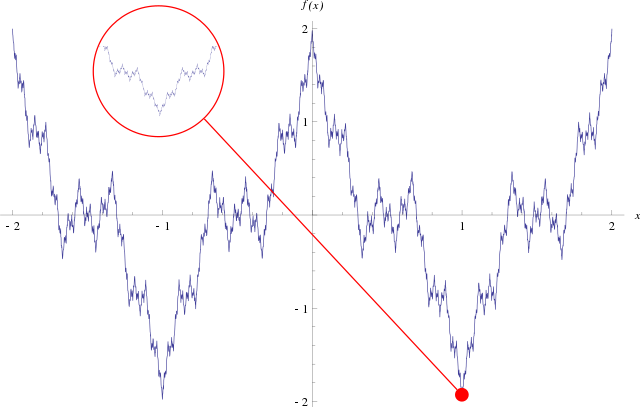Loading AI tools
Function that is continuous everywhere but differentiable nowhere From Wikipedia, the free encyclopedia
In mathematics, the Weierstrass function, named after its discoverer, Karl Weierstrass, is an example of a real-valued function that is continuous everywhere but differentiable nowhere. It is also an example of a fractal curve.

The Weierstrass function has been historically served the role of a pathological function, being the first published example (1872) specifically concocted to challenge the notion that every continuous function is differentiable except on a set of isolated points.[1] Weierstrass's demonstration that continuity did not imply almost-everywhere differentiability upended mathematics, overturning several proofs that relied on geometric intuition and vague definitions of smoothness. These types of functions were denounced by contemporaries: Henri Poincaré famously described them as "monsters" and called Weierstrass' work "an outrage against common sense", while Charles Hermite wrote that they were a "lamentable scourge". The functions were difficult to visualize until the arrival of computers in the next century, and the results did not gain wide acceptance until practical applications such as models of Brownian motion necessitated infinitely jagged functions (nowadays known as fractal curves).[2]

In Weierstrass's original paper, the function was defined as a Fourier series:
where , is a positive odd integer, and
The minimum value of for which there exists such that these constraints are satisfied is . This construction, along with the proof that the function is not differentiable over any interval, was first delivered by Weierstrass in a paper presented to the Königliche Akademie der Wissenschaften on 18 July 1872.[3][4][5]
Despite being differentiable nowhere, the function is continuous: Since the terms of the infinite series which defines it are bounded by and this has finite sum for , convergence of the sum of the terms is uniform by the Weierstrass M-test with . Since each partial sum is continuous, by the uniform limit theorem, it follows that is continuous. Additionally, since each partial sum is uniformly continuous, it follows that is also uniformly continuous.
It might be expected that a continuous function must have a derivative, or that the set of points where it is not differentiable should be countably infinite or finite. According to Weierstrass in his paper, earlier mathematicians including Gauss had often assumed that this was true. This might be because it is difficult to draw or visualise a continuous function whose set of nondifferentiable points is something other than a countable set of points. Analogous results for better behaved classes of continuous functions do exist, for example the Lipschitz functions, whose set of non-differentiability points must be a Lebesgue null set (Rademacher's theorem). When we try to draw a general continuous function, we usually draw the graph of a function which is Lipschitz or otherwise well-behaved. Moreover, the fact that the set of non-differentiability points for a monotone function is measure-zero implies that the rapid oscillations of Weierstrass' function are necessary to ensure that it is nowhere-differentiable.
The Weierstrass function was one of the first fractals studied, although this term was not used until much later. The function has detail at every level, so zooming in on a piece of the curve does not show it getting progressively closer and closer to a straight line. Rather between any two points no matter how close, the function will not be monotone.
The computation of the Hausdorff dimension of the graph of the classical Weierstrass function was an open problem until 2018, while it was generally believed that .[6][7] That D is strictly less than 2 follows from the conditions on and from above. Only after more than 30 years was this proved rigorously.[8]
The term Weierstrass function is often used in real analysis to refer to any function with similar properties and construction to Weierstrass's original example. For example, the cosine function can be replaced in the infinite series by a piecewise linear "zigzag" function. G. H. Hardy showed that the function of the above construction is nowhere differentiable with the assumptions .[9]
The Weierstrass function is based on the earlier Riemann function, claimed to be differentiable nowhere. Occasionally, this function has also been called the Weierstrass function.[10]
While Bernhard Riemann strongly claimed that the function is differentiable nowhere, no evidence of this was published by Riemann, and Weierstrass noted that he did not find any evidence of it surviving either in Riemann's papers or orally from his students.
In 1916, G. H. Hardy confirmed that the function does not have a finite derivative in any value of where x is irrational or is rational with the form of either or , where A and B are integers.[9] In 1969, Joseph Gerver found that the Riemann function has a defined differential on every value of x that can be expressed in the form of with integer A and B, or rational multipliers of pi with an odd numerator and denominator. On these points, the function has a derivative of .[11] In 1971, J. Gerver showed that the function has no finite differential at the values of x that can be expressed in the form of , completing the problem of the differentiability of the Riemann function.[12]
As the Riemann function is differentiable only on a null set of points, it is differentiable almost nowhere.
It is convenient to write the Weierstrass function equivalently as
for . Then is Hölder continuous of exponent α, which is to say that there is a constant C such that
for all and .[13] Moreover, is Hölder continuous of all orders but not Lipschitz continuous.
It turns out that the Weierstrass function is far from being an isolated example: although it is "pathological", it is also "typical" of continuous functions:
Seamless Wikipedia browsing. On steroids.
Every time you click a link to Wikipedia, Wiktionary or Wikiquote in your browser's search results, it will show the modern Wikiwand interface.
Wikiwand extension is a five stars, simple, with minimum permission required to keep your browsing private, safe and transparent.